The outdoor sports industry classifies back country skiing as any skiing done on ungroomed snow. This could mean skiing on the local golf course, a farmer's fields, or the nearest woods trail. But the purest form of back country skiing marries the skills of cross country and downhill telemark skiing (done at ski areas) in a joyous union that allows the skier to ski anywhere there is snow. For eastern back country skiers the consummation of this marriage is climbing hills to ski down through forested slopes untracked by other humans.
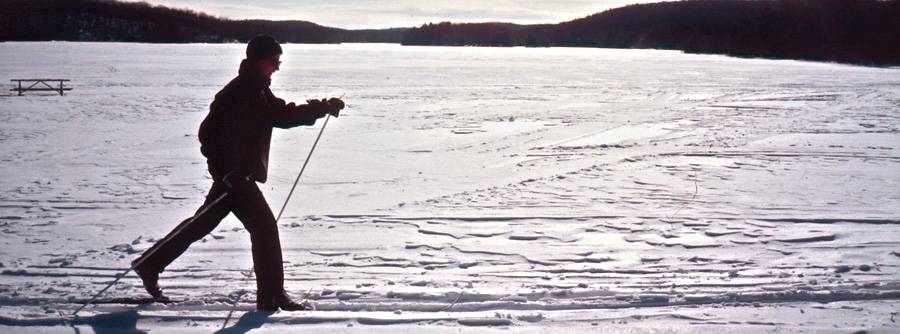
During the years when we are blessed with a substantial snow pack, Wawayanda State Park is one of the best places to build and explore back country skiing skills. Located in Northeastern Sussex County, the park's mountainous terrain ranges over 21,000 acres, offering a range of trails and slopes suitable for all levels of skiing.
My introduction to Wawayanda's snow vaults came years ago. An alpine skier with a strong pull to the forests, I began fantasizing about how I could ski the ravines I'd scouted on summer hikes. I was nineteen then and had visions of jumping cliffs, hurtling hell bent through the woods. Although it has taken me more than 30 years to acquire the skills and equipment for the task and hit the snow conditions just right to ski the most difficult routes in Wawayanda, I am happy to report some first-class back country skiing within spitting distance of New York City.
Wawayanda's topography, many trails and fire roads offer the back country skier a menu of options. Skiers of all levels can find terrain to suit the level of adventure they seek. This is where a topographic map comes in handy. Although Wawayanda's mountains may not be alpine massifs, there are cliffs, ravines and other precipitous drops that novices will want to avoid and experts will want to scout in advance. Altitude is another contributor to Wawayanda's skiability. Most of the park sits on a high plateau ranging from 1100 to 1400 feet, resulting in appreciably greater snowfall accumulation than areas just a few miles south or east.
Back country skiing terrain, though often accessible by trails, is not marked on maps. It must be found. Summer hikes or mountain biking, where allowed, are great ways to scout terrain during the off-season. A bicycle allows quicker exploration of a wider range of terrain, while also gauging downhill pitches more accurately. Skiing on good snow tends to be somewhere between biking and walking. The bicycle with its wheels on ball bearings has little if any rolling resistance; feet have lots. So a downhill that requires some braking on a bike is probably just right for a nice glide on skis.
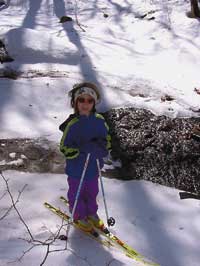
For beginning back country skiers Wawayanda has some natural starting points. Try an easy loop on the snowed-over bike path of the main road, heading south from the Ranger station parking lot, then right onto Old Wawayanda Road to the continuation of the Appalachian Trail on the right. This feeds into the Hofferlin Trail and back to the Ranger Station.
A longer, more challenging loop reverses the approach. Head west at the Ranger Station on the Hofferlin Trail, merge left into the Appalachian Trail, out to Old Wawayanda Road, then up a modest hill on the Appalachian Trail heading west, to Iron Mountain Road heading southwest. Stay on Iron Mountain Road until it feeds out to the main entrance road. From there, ski the bike path northeast, back to the Ranger Station.
Intermediate skiers should be able to handle some steeper trails. A test of your skills starts at the interior beach parking lot. Head east along the perimeter of the lake. Ski past the boat house to the main dam. Go right onto the Wing Dam trail. This scenic trail winds through a maple forest, over the second dam and waterfall, then through groves of evergreen mountain laurel. Eventually you will be confronted by a steep hill that can be overcome by skiing S-shaped traverses that intersect the trail. Some folks remove their skis and walk up, but this is bad for the snow on the trail, not very effective in deep snow and doesn't help build the traverse-climbing skills skiers need to advance. At the hilltop bear left with care. The steep chute, a short piece of terrain skiable only by experts, leads to the Laurel Pond Trail. Make a left for a leisurely downhill ski down a roller coaster series of turns, drops and rises. Turn left at the old furnace to ski back to the beach parking lot.
Expert back country skiers can make a slight detour from the Wind Dam Trail loop for some great downhill runs. Before reaching the steep climb on the Wing Dam Trail, an open treed bowl lies on the right. Climbing this with a series of traverses presents a terrific downhill glade run. To avoid the awkward trail climb, simply traverse up the bowl then bear left, heading east to the Laurel Pond Trail.
Experts will also enjoy skiing terrain and open forest off the top off Wawayanda Mountain. Parking for these jaunts is tough to find in snowy winters but try the parking lot at Barrett House, home to the Vernon Historical Society. It's usually plowed in the winter. From there head west on the Appalachian Trail. You ski some serious climbs and drops here. Uphill traverse skills, kick turns and serious downhill capabilities are a must. The trail leads through ravines, down chutes and gorges, then back up to rolling maple forest, to Wawayanda Mountain's highest point.
A caution for explorers: Climbing the Appalachian Trail from the route 94 parking lot is not feasible on skis. It is so steep that under some winter conditions it becomes impassable or crampons are needed for icy conditions.
Maximizing your fun on a back country ski jaunt requires specialized gear. Regular cross-country ski equipment or even light back country gear won't do. Sure, it's fine for a relaxing fire road tour, but if you want to bag some drops, you'll need specialized equipment. Cross-country stuff is too light for this job. Heavier on-piste (groomed area, for non-Francophiles) Telemark gear also misses the mark. It's too clunky for the sprightly woods wedeling you intend.

Only in recent years have ski manufacturers produced hybrid equipment that marries the best features of alpine Telemark equipment to the attributes of cross-country touring classics. The skis are the length and width of alpine skis, but with the double cambered (flex pattern) construction of a cross-county ski. There are few ski shops that are knowledgeable in the area of back country hybrid skis, but they are worth consulting to make sure you are skiing on the right gear. Campmor in Paramus, New Jersey, (201-445-5000) Neil's Sports Emporium, in Sussex, New Jersey, (973-445-5000) and Nestor's in Quakertown or Whitehall, Pennsylvania (800-898-1133) are all great places to get advice and purchase the tools for back country skiing.
Boots have joined the stiff support of alpine boots to the softer comfort of leather cross-country footwear. Bindings and poles too, have met half way between the sports and mutated. The result of this cross-discipline cross-pollinated gear that is perfect for an assault on the best skiing Wawayanda has to offer. Adjustable poles and heavy-duty three pin bindings (without cables) complete the package. Your back country ski shop can help you select the exact equipment for comfort and effectiveness.
Finally it snows. You go hog wild. You call the Wawayanda ranger station and they tell you there's eight inches of fresh snow. You call in sick to work, hurl your gear into the car and break a variety of traffic rules to get there. You can taste the first tracks through that glade you scouted last summer.
Not so fast! Like fine wine, winter needs to develop a bouquet for the best back country skiing. Sure it's possible to ski the first snowfalls, but you'll destroy your new gear on rocks and stumps that poke through the unpacked snow. This is why many back country skiers reserve an old pair of cross-country skis as "rock-skis," while waiting for conditions to blossom. Some winters this doesn't happen at all. In others the peak comes in late winter or early spring.
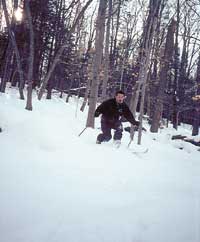
Ideal back country conditions result from multiple snowfalls. The best conditions set up when a series of heavy, wet snowfalls, or borderline sleet/rain precipitation events occur. A suitable base for skiing back country is 12 inches and when snow depths hit 18 36 inches the parks are wide open for skiing, with most rocks, logs and stumps covered. Long periods of low temperatures, are also helpful, freezing over creeks and lakes for easy transit. Freeze-thaw cycles also help recrystalize snow and firm the base so that skis won't penetrate to obstacles below.
Once a base is on the ground watch for storms that start as rain and sleet then switch to snow as temperatures plunge. The wet start of precipitation "sets up" (concrete pourer's terminology, also used by alpine area grooming technicians) as the temperatures drop, bonding to the snow that falls on top. As little as three inches of fluffy cover make for good skiing with edged skis, but the ideal is six to eight inches. When this happens it really is time to call in sick and hit the woods.
If temperatures stay cold after a fresh light topping of powder, the yield can be five to seven days of premium back country skiing. It doesn't last, so grab it when available. These conditions often occur in January and February.
Half way between winter and spring, the confused month of March is often a cauldron of wild weather that the general populace hates, but back country skiers love. March blizzards can lay down a three-foot base in a 24-hour period. Although this kind of deep snow is at first unskiable the freeze/thaw cycles that follow eventually turn the snow it to what back country skiers call "poor man's powder" corn snow. When freezing temperatures yield warm sunny days, it's time to get in the last and best runs of back country skiing in the Skylands.
Snow may be melted off on south facing slopes, at altitudes just a few hundred feet lower, or in locations just a mile or two east or south of the highest peaks. I've skied 18 inches of corn snow on north facing slopes, when other places had no snow remaining. These conditions can last into the first week in April while daffodils may be blooming in the flatlands.
The firm base and soft granular top layer found in spring is also sometimes referred to as "hero snow." It is so good for skiing that it bolsters confidence, hides technical mistakes and allows heroic recoveries from gross errors. And March is also the time when a season's worth of practice yields results!
To be a back country hero you'll need to shred the steeps. You've scouted them and decided that in the right snow conditions you might try a steep spot or two.
First you'll want to make sure your quiver of turns is well in hand. Telemark skiing lessons will go a long way to establish this capability, as do cross-country lessons. As is the case with gear, much of what is advanced back country technique is a hybrid of cross-country and downhill (Telemark) forms. Join the two successfully and you'll shine in the woods.
Wedge turns, Stem Christies, Step Turns, Parallel Turns, Telemark Turns (there are about 6 mutations of this one) should all be within the skiers grasp before attempting a more difficult back country treed descent. Then work up to the glory of the big drops. Safety should be your first concern, fun second, because it's hard to have fun with a broken or sprained anything.
Start with short pitches. Find a little drop with a safe run-out, climb up and try out your stuff. Wawayanda has lots of these. The park's undulating terrain can offer as many as three or four short drops that empty into a bowl or ravine. These spots are both playgrounds and training grounds. They allow the skier to explore different angles of descent, obstacles and conditions. Try an open slope first. Then ski some widely spaced trees to add challenge then weave between some rocks and stumps. Shady sides, sunny sides are next, to feel out the snow variations. It's easy to spend two hours or more knocking around the knobs and knolls tucked into the Wawayanda's snowy outback. Work slowly toward longer steeper descents. Stay on terrain that presents difficulties until you've developed your technique beyond its challenges. Only then is it time to move to the next challenge.
Steep climbs are as much an art as steep descents. The best back country skiers take as much pride in their lines of ascent as they do the swooping S-turns through trees. The art of climbing on skis comes from using terrain features and tactics to make climbing nearly effortless. This is much the same as skiing downhill and using terrain and tactics to control speed effortlessly. The back country skier that walks up a trail in his boots misses these uphill terrain-reading lessons.
Back country skiing is fraught with inherent risks. Myriad dangers await those who don't think, plan and take precautions. Sometimes just recognizing a risk helps avoid it. Anticipating a "stubby" (short, often jagged, branch or trunk stub protruding from the ground or a fallen tree trunk) can be enough to make a skier throw his body in a direction that prevents impalement (you don't want to know the possibilities). Skiing with a partner can guarantee someone to hang onto while limping out. Wearing eye protection can prevent a lacerated cornea. Removing pole straps before any treed descent can save a skier from becoming acquainted with the excruciating pain and season-long healing time of a separated shoulder, when the pole is caught on a tree branch. Slathering up with sunscreen can mean years of enjoying Wawayanda's pleasures without the setbacks of sunburn.
Some folks insist on compasses, maps, GPS (Global Positioning System) devices, signal flares and a host of back country apocalypse paraphernalia. Here it's best to know your limitations. I prefer to memorize maps and know the terrain I ski. I rest easy knowing that following a water flow downhill usually leads to a road in this part of the country. But each skier has a different sense of direction and memory. Consider yours before you venture into the winter woods.
For the forest turns frigid in the winter night. And coyotes howl in the moonlight from atop Wawayanda's snow covered ridges.
You can enter the Wawayanda State Park at the main entrance off Warwick-Greenwood Lake Turnpike, accessed from the west off route 94 in Vernon, New Jersey or from the east off Union Valley Road in West Milford. From the southwest you can reach the back entrance gate parking space from route 23 by following Cannistear Road to Wawayanda Road, which leads directly to the gate. 973/853-4462
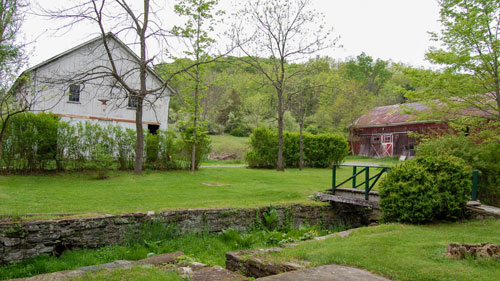
Peters Valley shares the experience of the American Craft Movement with interactive learning through a series of workshops. A shop and gallery showcases the contemporary craft of residents and other talented artists at the Crafts Center... ceramics, glass, jewelry, wood and more in a beautiful natural setting. Open year round.
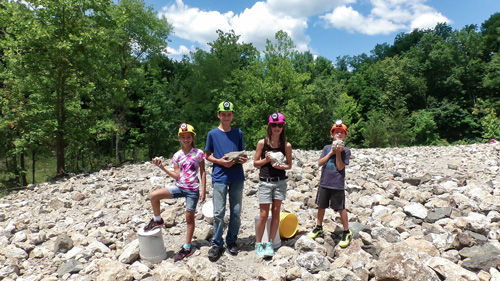
“The Fluorescent Mineral Capitol of the World" Fluorescent, local & worldwide minerals, fossils, artifacts, two-level mine replica.
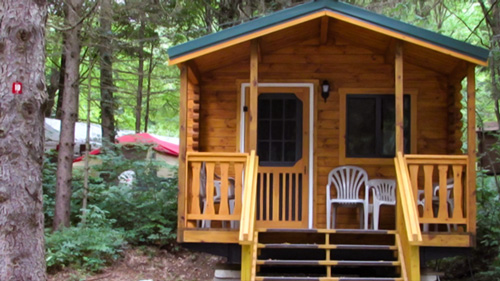
Located in Sussex County near the Kittatinny Mountains the camping resort offers park model, cabin and luxury tent rentals as well as trailer or tent campsites with water, electric and cable TV hookups on 200 scenic acres.
Follow the tiny but mighty Wallkill River on its 88.3-mile journey north through eastern Sussex County into New York State.